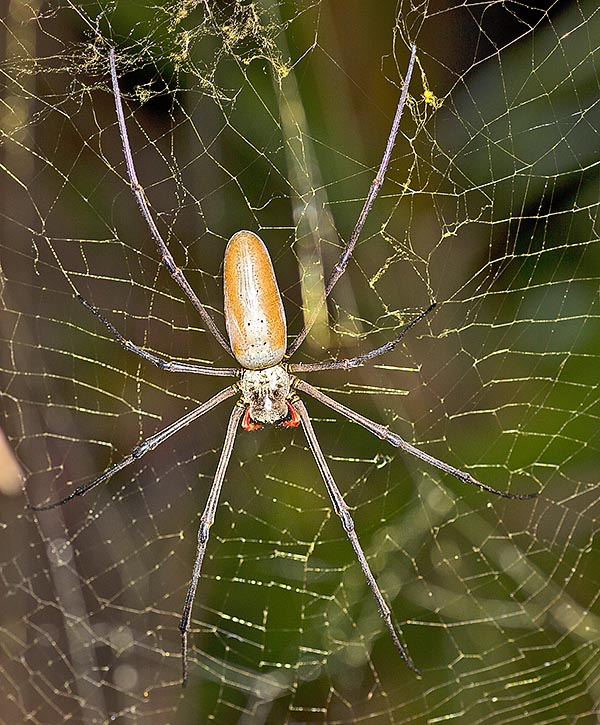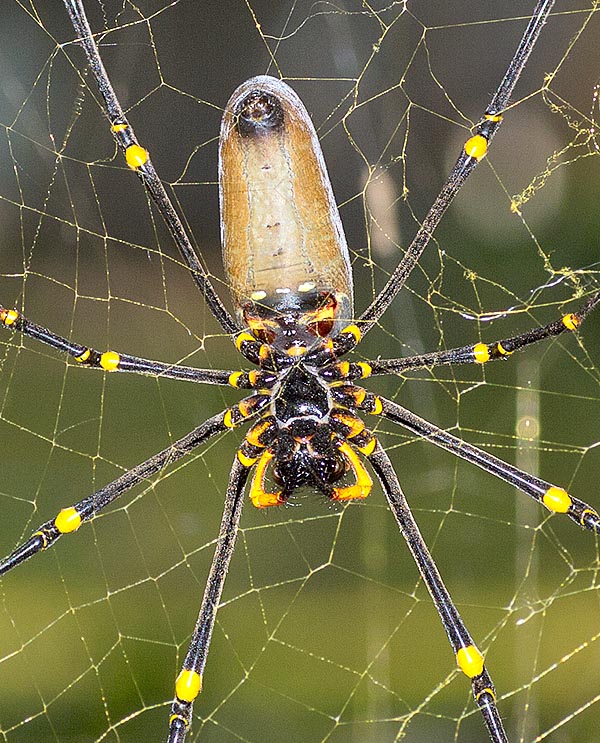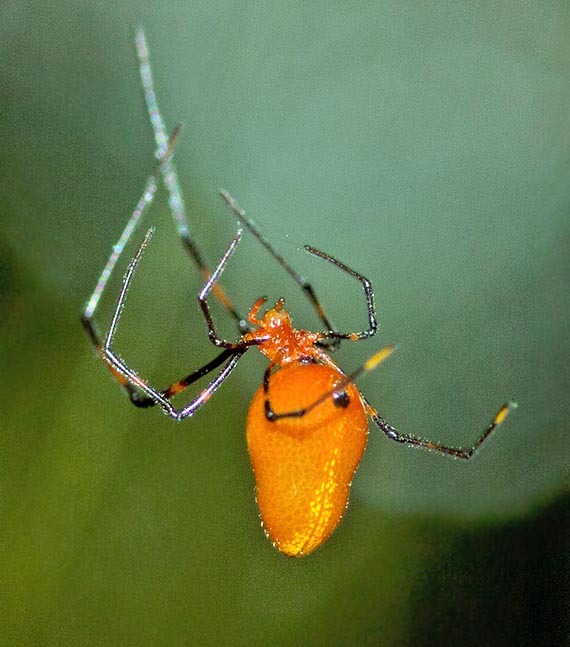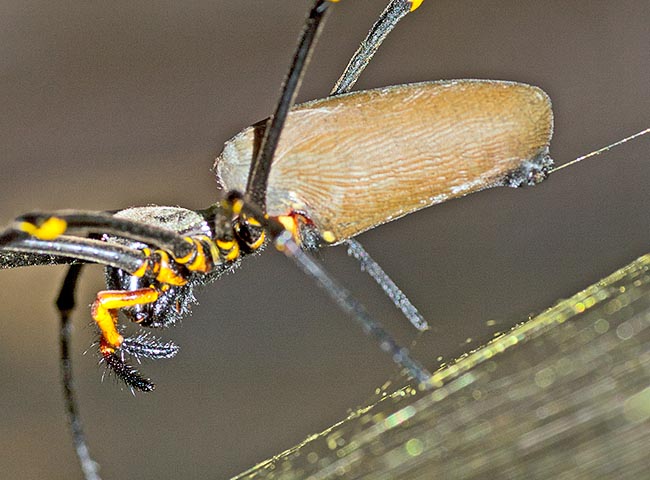Family : Nephilidae

Text © Prof. Giorgio Venturini

English translation by Mario Beltramini

Nephila pilipes is present in northern Australia, New Guinea and various tropical Asia areas © G. Venturini
The genus Nephila includes about 150 species with cosmopolitan diffusion, with species present in the warm regions of Asia, Africa, Australia and Americas.
These spiders are characterized usually by the big size of the females, by the elongated shape of the body, by the long legs and by their being multi-coloured.
The species Nephila pilipes, including about 9 subspecies, belongs to the order Araneae and to the family Nephilidae.
The genus Nephila is the oldest genus of the nowadays extant spiders, as proved by fossil specimens dated about 165 million of years.
The name comes from the Greek νεω (neo) = thread, I weave + φίλεω (fileo) = I love; therefore, who loves weaving, in reference to the big webs; whilst the name of the species pilipes comes from the Latin “pilum” = javelin and “pes” = foot, therefore, with the long legs shaped like a javelin.
Zoogeography
The Nephila pilipes is present in Australia, especially in the northern regions, in New Guinea and in various areas of tropical Asia.
In Australia the females of the golden orb are the most famous spiders: enormous and very showy, they tend their spectacular golden webs clearly visible in open spaces.
In Australia is present also the species Nephila plumipes and Nephila edulis, very similar.
The name “edulis” means edible in Latin, referring to the fact that the locals at New Caledonia ate it. In fact, not only N. edulis, but also other species of the genus Nephila were eaten after roasting them over the fire
Ecology-Habitat
The tiger spider lives in the dry forests and in the thickets, on the coastal dunes and in the mangrove forests.

It's one of the biggest known spiders. Female has an about 5 cm body and with the legs exceeds 15 cm © Giorgio Venturini
Nephila pilipes, as well as Nephila plumipes, a very similar spider, are two of the largest spiders as of today, having their females a body length that can be well over 5 cm, with a total length of more than 15 cm (the largest individual of Nephila was a female of N. plumipes, found in Queensland whose body was 6.9 cm long).
The colouration of the body varies from grey-silver to brown to violaceous, with the evident black spinnerets. The legs are black with yellow bands very evident close to the joints (hence the name of “tiger spider”) which draw the knees. The last segment of the legs (tarsus) is much elongated, hence the name pilipes (javelin shaped feet). The shape of the body us cylindrical elongated in the young specimens, whilst when the opisthosoma is full of eggs it assumes a globose look. Characteristic of this species is the yellow and red colour of the palps, with the last segment black, and the absence, in the adult females, of tufts of hairs on the legs, otherwise present in the juvenile forms. The sternum is usually black. Similar species like Nephila plumipes, present the tufts of hairs in the legs also in the adult.
The male is much smaller (about 5 mm) and of reddish brown colour, with pyriform opisthosoma and darker or black legs presenting usually some reddish annulations.
Ethology-Reproductive Biology
Among all webs, that of the tiger spider is the biggest and the most resistant and is a complex structure, with an adherent net with thin mesh suspended between non adhesive webs having the function of protective barrier.
It has been recently discovered that the web of some Nephila contains repellent substances for the ants that protect the structure. The main portion of the web, circular, can have a diameter over the metre, whilst the anchoring cables can be much longer. When a prey stumbles into the web, the threads can elongate of almost three times without breaking and absorb therefore the kinetic energy of the insect also in case of heavy and fast flying preys. In case of strong bad weather the spider undoes part of the web producing openings which allow the strong winds to pass through them without producing damages.
In the sun, the yellow threads of the web shine like gold. The colour is due to the xanthurenic acid and to other compounds. It seems that the particular colouration attracts some insects, furthermore, the spider can modify the colour of the thread in order to adapt it to the ambient characteristics.

The male, reddish with pyriform opisthosoma, hardly reaches 5 cm and even if usually is not eaten by the bride, starts the courting very carefully © Giorgio Venturini
The most common preys include flies, coleopterans, moths and cicadas. Often the web is enough strong to be able to trap small birds or bats and in these cases the spider wraps also these preys and eats them.
It has been observed an individual who had seized and was eating an about half a metre long snake.
Similarly to other spiders, in case of disturbance, the tiger spider makes the web vibrating, thus confusing possible aggressors.
In some instances, various specimens build their webs very close each other, creating a complex of webs partially overlapped.
The webs of Nephila at times host small spiders of other genera, such as Argyrodes who nourish of small trapped insects and so contribute to the cleaning of the web. In some cases a high number of these spiders may subtract food to the owner of the web or even eat the newborn spiders.
It is frequent that around the web built by a female of Nephila pilipes stay several males waiting for a possible mating.
After the coupling, the female wraps its unique ovigerous sac, containing up to 2000 eggs, in a casing of golden silk threads and buries it in the ground, unlike other species of the genus Nephila which instead hide it in the vegetation out from the web, protected by folded leaves or by a tangle of wigs.
The mating is a dangerous activity for the small male and for this reason it begins the courting very carefully. In any case, in this species in particular the male usually is not eaten after the coupling. Despite the big size, the Nephila pilipes lives one year only.
These spiders are prey of various birds and of wasps of the family Sphecidae. The wasp lands on the web, with the vibrations attracts the spider at the periphery and then paralyzes it with a sting using it as live food for its progeny.

The thread has resistance to traction bigger than the steel and promises medical employments © Giorgio Venturini
The tiger spiders are little aggressive and bite the man only exceptionally. The symptoms of the bite consist in localized pain and swelling, more rarely do appear nausea and vertigoes.
Utilizations of the thread
By utilizing the thread obtained from more than one million of webs of tiger spiders has been produced, with a three years work, a golden coloured shawl, exhibited in a London museum.
A possible more interesting use is the bioengineering one. Some experimental studies suggest that the thread of this spider is an excellent support for the tissues regeneration, thanks to its resistance, biocompatibility and capacity of promote the adhesion and the cellular proliferation.
In particular, the silk of Nephila has been recently proposed as support for the regeneration of the nerves in the mammals. Experiments on cultured neurons have shown that one single thread of silk of Nephila can drive a regenerating axon towards its target. The resistance to the traction of the spider thread is greater than that of the steel of the Kevlar and, moreover, is not recognized by the immune system.
Synonyms
Aranea longipes Fabricius, 1781; Aranea maculata Fabricius, 1793; Aranea pilipes Fabricius, 1793; Aranea sebae Walckenaer, 1802; Epeira chrysogaster Walckenaer, 1805; Nephila maculata (Fabricius, 1793); Nephila fuscipes C.L. Koch, 1839; Epeira fuscipes C.L. Koch, 1839; Epeira doreyana Walckenaer, 1841; Epeira caliginosa Walckenaer, 1841; Nephila ornata Adams, 1847; Epeira penicillum Doleschall, 1857; Epeira harpyia Doleschall, 1859; Nephila chrysogaster Walckenaer, 1805; Nephila pecuniosa L. Koch, 1872; Nephila aurosa L. Koch, 1872; Nephila procera L. Koch, 1872; Nephila sulphurosa L. Koch, 1872; Nephila tenuipes L. Koch, 1872; Nephila submaculata Strand, 1906.
